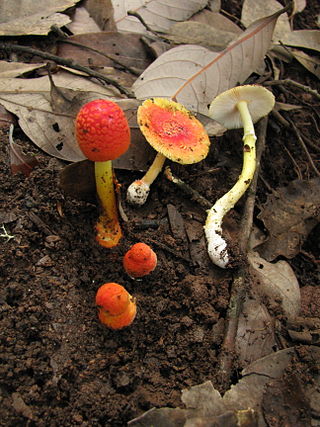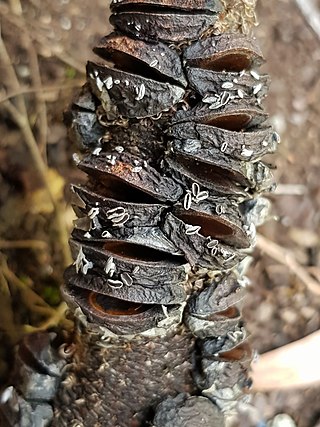Related Research Articles
MycoBank is an online database, documenting new mycological names and combinations, eventually combined with descriptions and illustrations. It is run by the Westerdijk Fungal Biodiversity Institute in Utrecht.
Pyrenophora avenae is a species of fungus in the family Pleosporaceae. It is a plant pathogen, causing leaf stripe, blotch or spot and seedling blight of oats.

Ombrophila is a genus of fungi in the family Helotiaceae. The genus contains 11 species. Elias Fries circumscribed Ombrophila in 1849.
Mycaureola is a genus of fungi in the family Physalacriaceae of mushrooms. Circumscribed in 1922 by French mycologists René Maire and Émile Chemin, the genus is monotypic, containing the single species Mycaureola dilseae. The fungus is a parasite of the red algal species Dilsea carnosa, on which it causes circular necrotic lesions.

Gyrophragmium is a genus of fungi in the family Agaricaceae. The genus was circumscribed by French botanist Camille Montagne in 1843.
Haasiella is a fungal genus in the family Hygrophoraceae. It is a monotypic genus that contains only the species Haasiella splendidissima. Haasiella venustissima, formerly considered to be a distinct species based on its one and two-spored basidia, was found by a DNA study to be synonymous with H. splendidissima. H. splendidissima is only known from Europe and is saprotrophic on wood. Haasiella was described as a new genus in 1966 by Czech mycologists František Kotlaba and Zdeněk Pouzar. It is most closely related to the genus Hygrophorus.
Pachysolen is a genus of yeast discovered from sulfite liquor by Boidin and Adzet (1957) and isolated by Wickerham (1970).

The Mixiomycetes are a class of fungi in the Pucciniomycotina subdivision of the Basidiomycota. The class contains a single order, the Mixiales, which in turn contains a single family, the Mixiaceae that circumscribes the monotypic genus Mixia. Only one species has been described to date, Mixia osmundae; this species was originally named Taphrina osmundae by Japanese mycologist Toji Nishida in 1911. It is characterized by having multinucleate hyphae, and by producing multiple spores on sporogenous cells.

Amanita rubrovolvata, commonly known as the red volva amanita, is a species of fungus in the family Amanitaceae. First described scientifically by the Japanese mycologist S. Imai in 1939, it is widely distributed in eastern Asia. The fungus produces small to medium-sized mushrooms, with reddish-orange caps up to 6.5 mm (0.26 in) wide. The stems are up to 100 mm (3.9 in) tall, cream above the ring and cream to yellowish below it. The stem ends in a roughly spherical bulb at the base, which is covered with bright orange patches. Neither edibility nor toxicity have been established for the fungus, but it is suspected to be associated with neurological anomalies. Several molecular studies have confirmed the mushroom's classification in the subgenus Amanita of the genus Amanita, along with closely related species such as A. muscaria.
Austrogautieria is a genus of truffle-like fungi in the family Gallaceaceae. Segregated from the genus Gautieria in 1986, the genus contains six species found in Australia.

Tricholosporum porphyrophyllum is a species of fungus in the family Tricholomataceae. It is found in Asia.

Balsamia is a genus of truffle-like ascomycete fungi of the family Helvellaceae. The widespread genus contains twenty five species known from Europe, North America, North Africa and Asia, including China.

Leucangium is a genus of ascomycete fungi. The genus was circumscribed by French mycologist Lucien Quélet in 1883. Although classified in the Helvellaceae in the past, molecular analysis indicates it is closely related to the genus Fischerula and Imaia, and therefore must be placed in the Morchellaceae. The genus includes two species, Leucangium ophthalmosporum Quél. and L. carthusianum Paol., and both of them produce sequestrate ascoma, globose to ellipsoidal ascus, and dark olive-colored to grayish green, smooth, fusiform ascospores.

Banksiamyces toomansis is a species of fungus in the family Helotiaceae. It was first described as Tympanis toomansis by Miles Joseph Berkeley and Christopher Edmund Broome in 1886, and transferred to the genus Encoelia in 1957 by R.W.G. Dennis. Gordon William Beaton transferred it to Banksiamyces in 1982.
The Morispora is a genus of rust fungi in the family Phragmidiaceae. The genus is monotypic, containing the single South American species Morispora tenella.
Trachyspora is a genus of rust fungi in the family Phragmidiaceae. The genus, widespread in northern temperate areas, contains six species.

Ductifera is a genus of fungi in the order Auriculariales. The genus is widespread, especially in tropical regions, and contains about 11 species. The genus was circumscribed by American mycologist Curtis Gates Lloyd in 1917.
Nothocastoreum is a fungal genus in the Mesophelliaceae family. The genus is monotypic, containing the single truffle-like species Nothocastoreum cretaceum, found in Australia.

Phallus cinnabarinus is a species of fungus in the stinkhorn family. Originally named in 1957 as Dictyophora cinnabarina, it was transferred to the genus Phallus in 1996 by Hanns Kreisel. It is found in Taiwan.
Conocybe velutipes is a species of mushroom in the Bolbitiaceae family. It contains the psychedelic alkaloids psilocybin and psilocin.
References
- ↑ "Circulocolumella S. Ito & S. Imai 1957". MycoBank. International Mycological Association. Retrieved 2011-11-20.
- ↑ "Circulocolumella hahashimensis (S. Ito & S. Imai) S. Ito & S. Imai 1957". MycoBank. International Mycological Association. Retrieved 2011-11-20.
- ↑ Kirk PM, Cannon PF, Minter DW, Stalpers JA (2008). Dictionary of the Fungi (10th ed.). Wallingford, UK: CABI. p. 144. ISBN 978-0-85199-826-8.